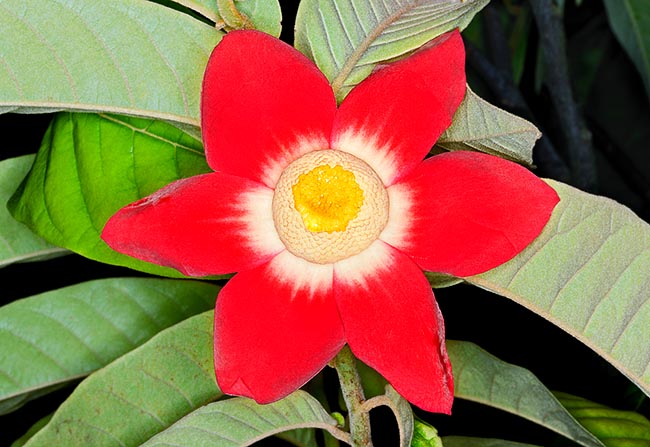Family : Annonaceae

Text © Pietro Puccio

English translation by Mario Beltramini

Uvaria grandiflora flowers reach 11 cm. Leaves, bark and roots are medicinal © Giuseppe Mazza
The species is native to China (Guangdong, Guangxi and Hainan), Indonesia, Malaysia, Myanmar, Philippines, Thailand and Vietnam, where it grows in the open forests up to about 1000 m of altitude.
The name of the genus is the Latin adjective “uvarius, a, um”, from “uva” = grape, therefore, similar to a bunch of grapes, with reference to the fruits of some species of the genus; the name of the species is the combination of the Latin terms “grandis” = great and “flos, -oris” = flower, with obvious reference.
The Uvaria grandiflora Roxb. ex Hornem. (1819) is an evergreen sarmentose shrub, up to 10 m tall, with the young branches covered by a rusty coloured tomentum. The leaves, on a 0,5-1 cm long petiole, are alternate, simple, entire, obovate-oblong with pointed apex and prominent venations, 7-25 cm long and 4-10 cm broad, of intense green colour, pubescent below.
Solitary flowers, rarely 2-3, hermaphroditic, from the opposite side of the leaf on a 0,5-5 cm long pedicel, of 7-11 cm of diameter, with calyx having 3 ovate lobes with obtuse to acute apex, about 2 cm long and 3 cm broad, of yellowish green colour, and 6 petals, three internal obovate-oblong and three ovate external ones, of almost similar size, about 4 cm long and 3 cm broad, thick and slightly villous, of vermillion red colour turning, with the time, purple, cream yellow at the base. The numerous stamina form, together with the pistils, a compact globe at the centre of the flower.
The fruit is a bunch of monocarps, on 1,5-3 cm long pedicel, almost cylindrical with mucronate apex, tomentose, of orange yellow colour, 3-7 cm long and of 1,5-2 cm of diameter, with fleshy pulp containing 5-20 pale brown ovoid, flattened, seeds. It reproduces by seed, previously kept in water for 1-2 days, in organic loam with addition of sand or perlite per 30%, kept humid, at the temperature of 24-26 °C, with germination times of 1-2 months and first flowering when it has reached the height of about 1 m, and by cutting.
It is a vigorous species with the great showy flowers, rather rare out from the origin areas, cultivable in the tropical and subtropical climate zones in full sun or partial shade. It is not particular about the soil, provided this is draining, and, well rooted, it can bear drought periods; utilizable for ornamental purposes attached to walls or leaning against robust railings.
Cultivable also in pot, where the climate does not allow the open air permanence during the whole year, in luminous ambients with temperatures not under the 15 °C; the watering must be regular and abundant in summer, spaced in winter, allowing the substratum to dry up partially, and the fertilizations, during the vegetative period, done with products balanced with microelements. The fruits are edible, with rather sweetish pulp not particularly appreciated, and consumed raw or utilized for preserves.
Leaves, bark and roots are variously used in the traditional medicine for various pathologies; laboratory studies have evidenced the presence in the extracts of bark of flavonoids with high antibacterial and antioxidant activity.
Synonyms: Unona grandiflora DC. (1824); Uvaria purpurea Blume (1825); Uvaria platypetala Champ. ex Benth. (1851); Uvaria rhodantha Hance (1851).
→ To appreciate the biodiversity within ANNONACEAE family and find other species, please click here.
